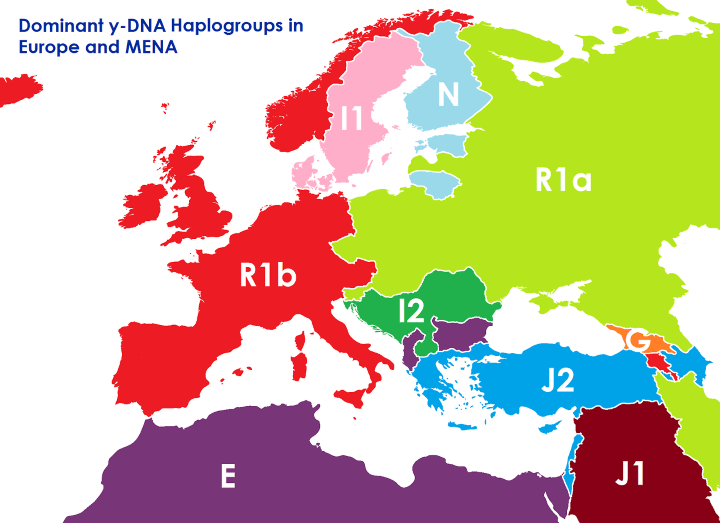
Most of us are used to seeing maps with borders that are determined by nationality and ethnicity. But here’s a different kind of map that shows what the boundaries of Northern Africa, the Middle East, and Europe would look like if they were drawn based on the predominant Y haplogroups in those regions.

Most of us are used to seeing maps with borders that are determined by nationality and ethnicity. But here’s a different kind of map that shows what the boundaries of Northern Africa, the Middle East, and Europe would look like if they were drawn based on the predominant Y haplogroups in those regions.
We’ve also provided you with some general information about all of these haplogroups. Take a look.
| Haplogroups | Description |
| Haplogroup R1b | R1b is the most prevalent haplogroup of Western Europe. It includes 80% of the population in the Scottish Highlands, Western Wales, Ireland the, the Atlantic edge of France, Catalonia, and the Basque country. It also covers smaller areas across Eastern Europe, portions of Western and Central Asia, and parts of North Africa. |
| Haplogroup R1a | R1a is a haplogroup with an extent covering a massive portion of Eurasia, and reaching all the way from Scandinavia, Central Europe and the south of Siberia to southern parts of Asia. |
| Haplogroup N | This haplogroup is very broadly distributed from Asia’s SouthEastern regions all the way to Eastern Europe. |
| Haplogroup I1 | I1 is the most pervasive haplogroup in Northern European regions. It’s found predominantly in Scandinavia and Finland, commonly representing more than 35% of the Y chromosomes. Essentially, it’s found in all places that were raided by the Vikings. |
| Haplogroup I2 | This haplogroup is the most prevalent paternal lineage in former Yugoslavia, Romania, Bulgaria and Sardinia. It’s widely present in the majority of Slavic countries. |
| Haplogroup J1 | In modern times, this haplogroup is most densely distributed across numerous regions in or close to the Middle East, as well as portions of the Caucasus, Ethiopia and the Sudan. It’s also densely present in areas of Southern Europe and Northern Africa, as well as in certain Jewish groups. However, its distribution extends even farther, and is observable across some other parts of Europe, Central Asia, and India. |
| Haplogroup J2 | J2 is one of the most common Y DNA haplogroups in the Middle East and in the Arab-speaking World, with its origins believed to be in modern-day Syria, Turkey, and Iraq. |
| Haplogroup E | Most people belonging to E-M96 actually fall into one of its established subgroups, with the E-M96 being particularly scarce. E1a and E-M75 are found almost only on the African continent. By observing the frequencies of major subgroups, five extremely general regions of Africa have been categorized: North, South, East, West, and Central. The division can be differentiated by the predominance of E-V38 in Western, Southern, Eastern, and Central Africa, with East, Central, Southern and West Africa, with E-M78 being in Eastern Africa and E-M81 being in Northern Africa. |
| Haplogroup G | G-M201 is mostly found in modern day Georgia, but it’s also observable in numerous other regional and minority groups in the Caucasus. Moreover, you can faintly see its distribution among various ethnic groups in parts of Northern Africa, Central Asia, Southern Asia, and Europe. |

